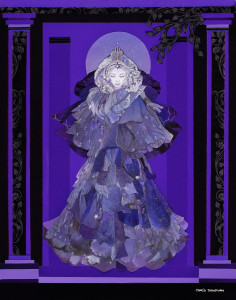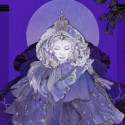Visual artists see variations in color that others don’t see. While everyone may sense the effect of color, non-artists miss the subtleties of the full spectrum.
The possibilities within one color family alone are literally infinite. This allows artists to be fully imaginative in their work and see opportunities and more options. One of the best ways to experience this is to study works of art that are considered monochromatic. While it may seem uninteresting upon first glance if you’re not familiar with works of art based on one color, upon closer examination the beauty is remarkable.

Monochromatic Apparition Series~ Blue-Violet
Chris Donovan
A monochromatic color scheme can create a strong feeling of elegance and simplicity. One of the most important ingredients in monochromatic works is the diversity of values from the darkest hue to the lightest. Values are used to add strength, richness, line, depth, and beauty to the work. Musicians use the same understanding to the full spectrum of tone color in performance; they have the ability to hear variations that non-musicians often miss. Theatrical and dance performance artists use lighting and costuming in the same way.
This work by Chris Donovan was created using tones, tints, shades and pure hues of the color Blue-Violet.
It is not the form that dictates the color, but the color that brings out the form.
~ Hans Hofmann
When you look at a color, what do you see? When you listen to music, what do you hear?

[sws_checklist]
- Do you notice the full spectrum of color values or the simple family name?
- Are you able to sense the color values and their subtle emotional impact?
- In music, do you hear the subtleties of color in a single instrument or voice?
- How does the color value fit within the overall work?
- Can you identify the full range of tonal values in an instrument or voice grouping?
- Do you hear the subtle emotional impact of each moment in the full spectrum of color?
- Can you identify how visual or aural color impacts the mood or emotional effect of the work?
- Are the color changes only slight changes in value, intense, or a combination of both?
- How do these variations influence your impression?
[/sws_checklist]
The real voyage of discovery consists not in
seeking new landscapes but in having new eyes.
~ Marcel Proust
As with art, life is most full when you experience the full spectrum it has to offer—from the values you identify in each moment to the bigger picture over time. Looking is not the same as seeing. Listening is not the same as hearing. Color is one of the most powerful tools artists have to create their art. The same concepts when applied to your life can significantly affect your experience. The problems in effectiveness of monochromatic color schemes most often lie in either too many highly contrasting values—causing distraction and chaos—or too few value changes, which causes the work to be bland, uninteresting, and uninspiring.
As with the artist creating or performing works of art, you will discover how the full spectrum of life experiences help you uncover your values and how they change or are put together over time to enhance who you are; you will begin to recognize how you feel and where you’re going with your life. It is one of the most fulfilling aspects of creating your way.
Before you tell your life what truths and values you have decided to live up to, let your life tell you what truths you embody, what values you represent.
~ Parker Palmer, Let Your Life Speak
Details are important, but don’t get caught up. Take time often to step back and see the full spectrum—where you are in relation to your overall destination. Create your art and enjoy the journey.
— Pat
